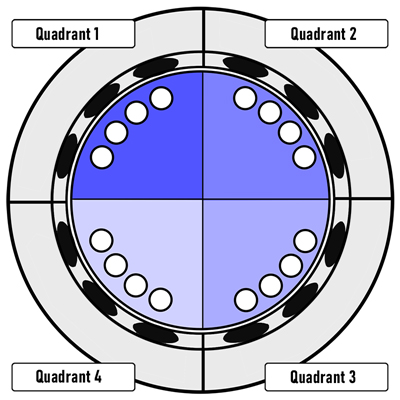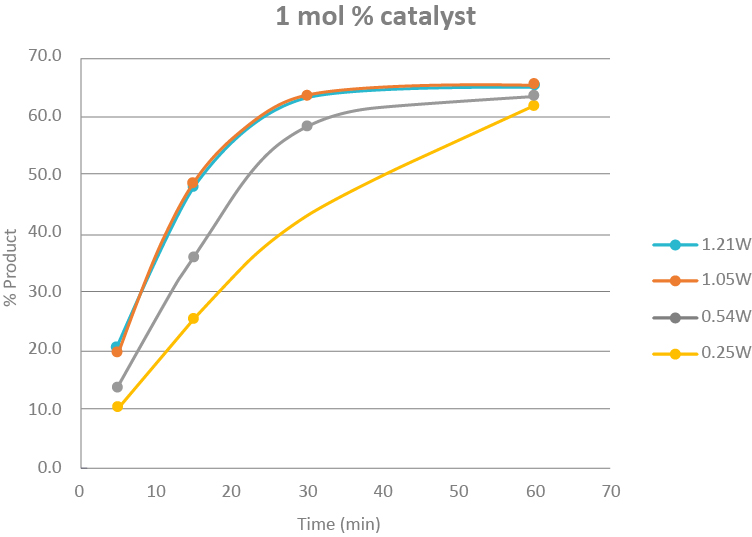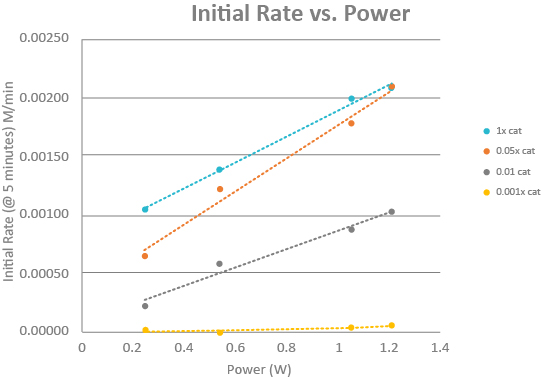
The Lucent360â„¢ LED modules and vial holders/reactors are fully interchangeable, giving users the flexibility to design experiments that perfectly match their specific needs. With customizable wavelengths, light intensities, vial arrangements, and temperature control, the system offers an almost endless range of options for custom optimization. This makes it easy to investigate reaction parameters at a small scale before scaling up using the same instrument.
A great example of the Lucent360â„¢'s adaptability is shown in the following experiment, which tested light intensity and catalyst concentration for an iridium-catalyzed C-C bond formation (see Figure 1).
Figure 1:

The Lucent 360™ multi-light screener (HCK1021-01-010) can run 16 reactions simultaneously at four different wavelengths and light intensities. In this test, the screen was conducted at 450 nm with four concentrations of iridium catalyst (1 mol%, 0.5 mol%, 0.1 mol%, and 0.01 mol%). Each setting corresponds to effective power levels ranging from 0.25 W to 1.2 W, translating into photon fluxes between 9.5×10-7 and 4.5×10-6 Einstein/s (moles of photons per second).
|
Effective Power/Reaction (W)
|
(+/-) |
Photon Flux (Einstein/s) |
| Quadrant 1 |
1.21 |
8.4% |
4.54E-06 |
| Quadrant 2 |
1.05 |
8.3% |
3.94E-06 |
| Quadrant 3 |
0.54 |
6.0% |
2.03E-06 |
| Quadrant 4 |
0.25 |
4.1% |
9.50E-07 |

The multi-light intensity/catalyst screen followed this procedure (Table 1): 4 ml vials were prepared with Teflon septa and stir bars, containing 1.1 mg Ni-glyme (5 mol%), 1.3 mg dtbbpy (5 mol%), and methanol. The solvent was removed under reduced pressure. Then, 48.9 mg Cs₂CO₃ (1.5 equiv.) was added under inert atmosphere. A 1 ml sparged solution in DMSO included 19.9 mg bromoacetophenone (100 µmol), 35.6 mg Boc-Val-OH (1.5 equiv.), and 7.7 mg biphenyl as an internal standard. The Ir(dF-CF₃-ppy)₂(dtbbpy) catalyst was added in DMSO to achieve 0.01, 0.1, 0.5, or 1 mol% concentration. The total volume was adjusted to 2.0 mL with additional DMSO. Reactions were carried out at 30°C under 450 nm LED light. Samples were taken at 5, 15, 30, and 60 minutes for LC-MS analysis (10 µL diluted to 1 mL in DMSO).
Table 1 : Experimental Details (for standard conditions)
| Reagent |
Equivalent |
Amount (µmol) |
0.05 |
M |
| bromoacetophenone |
1 |
100 |
19.9 |
mg |
| boc-Val-OH |
1.5 |
150 |
32.6 |
mg |
| Ir(dF-CF3-ppy)2(dtbbpy) |
0.01 |
1 |
1.1 |
mg |
| Ni-glyme |
0.05 |
5 |
1.1 |
mg |
| dtbbpyp |
0.05 |
5 |
1.3 |
mg |
| Cs2CO3 |
1.5 |
150 |
48.9 |
mg |
| Biphenyl |
0.5 |
50 |
7.7 |
mg |
| solvent |
DMSO |
0.05M |
0.002 |
L |
Over the course of one hour, clear trends emerged in product formation based on catalyst concentration and light intensity (Table 2). Reactions with 1 mol% Ir catalyst showed similar conversions (62–65%) after 60 minutes regardless of power level. At 0.5 mol%, power levels of 0.54 W or higher were sufficient for comparable conversion. Lower catalyst loadings, however, significantly reduced conversion, even at higher power settings.
Tableau 2 : Conversion at 60 minutes
|
Power (%) |
| Ir cat (mol%) |
0.25W |
0.54W |
1.05W |
1.21W |
| 1 |
62.0 |
63.5 |
65.6 |
65.2 |
| 0.5 |
47.8 |
65.1 |
67.7 |
65.8 |
| 0.1 |
15.7 |
33.7 |
45.2 |
47.7 |
| 0.01 |
1.0 |
0.2 |
2.6 |
2.6 |
Although the final conversion rates for the seven conditions marked in green in Table 2 are similar, significant differences were observed in the initial reaction rates and time to completion (Figure 3). Reactions at 1.0 W and 1.2 W reached completion within 30 minutes, while those at lower power levels required the full 60 minutes to finish.
Figure 3: Plot of time course for 1 mol % at 0.25W, 0.54W, 1.05W, and 1.21W

Based on these results, the reaction can be carried out using only 0.5 mol% photocatalyst and 0.54 W of power to achieve similar conversions to higher catalyst loads and higher light intensities—but with a slower overall rate (Figure 4).
Figure 4: Plot of time course for 0.54 W setting with 4 catalyst concentrations

By analyzing the initial reaction rate at 5 minutes, we can clearly see how light intensity significantly impacts the reaction speed. Increasing the initial rate is a crucial factor when determining optimal conditions for scaling up a photochemical process. For this particular C-C bond formation, we're still exploring the best approach, but without the flexible setup of the Lucent360â„¢ and its ability to monitor multiple light intensities simultaneously, it would have taken us much longer to gather all this data. For our next experiment, we might try testing four different nickel co-catalyst concentrations at each light intensity compared to the 0.5 mol% iridium catalyst, or even test additional wavelengths like 365 nm, 380 nm, or 405 nm, or adjust substrate concentrations. Whatever we choose, we know the Lucent360â„¢ will make it easy to carry out.
Figure 5 :

Know more:
- Contact us:
- Acess directly to the Lucent360â„¢ from Hepatochem on our website.
- Follow our news on LinkedIn
Cod Fillet/Portion
Cod Fillet,Cod Fish Fillet,Cooking Cod Fillets,Pan Fried Cod Fillet
ZHEJIANG EVERNEW SEAFOOD CO.,LTD , https://www.evernewseafood.com





